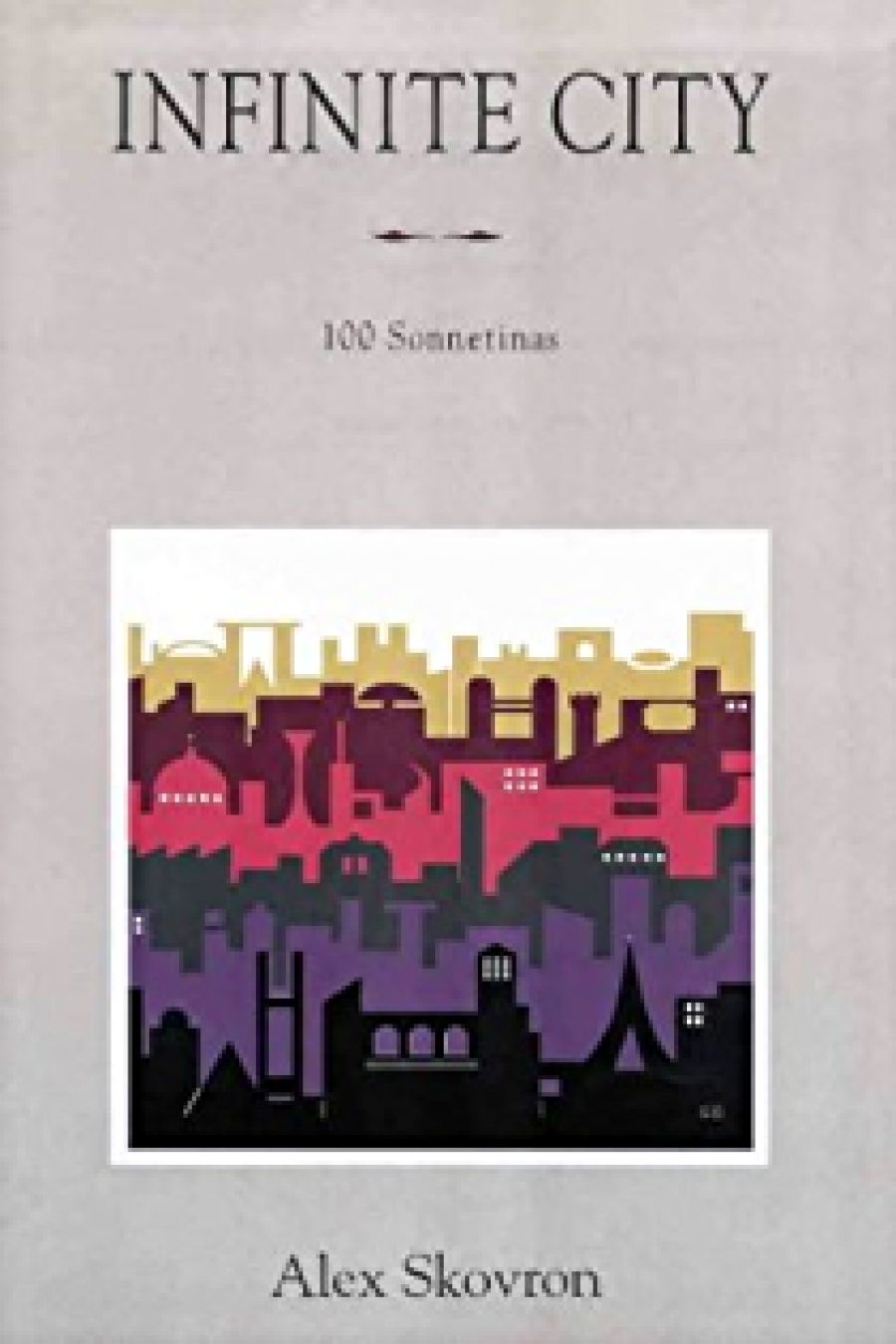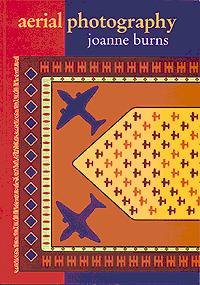
- Free Article: No
- Contents Category: Poetry
- Review Article: Yes
- Online Only: No
- Custom Highlight Text:
Despite the differences in style, careful logic seems to me to be the prevalent characteristic of both these accomplished poetry collections. Hard-won logic, too. In each, we are made aware often of the processes of achieving intellectual and emotional assessment and balance. As the titles indicate, poem after poem vividly accumulates details to settle on a succinct but more distanced and distancing overview.
- Book 1 Title: Infinite City
- Book 1 Subtitle: 100 Sonnetinas
- Book 1 Biblio: Five Islands Press, $13.95pb, 103pp
- Book 2 Title: Aerial Photography
- Book 2 Biblio: Five Islands Press $12.95pb, 92pp
- Book 2 Cover Small (400 x 600):

- Book 2 Cover (800 x 1200):

- Book 2 Cover Path (no longer required): images/ABR_Digitising_2021/Apr_2021/ezgif-1-fbb878d775f3.jpg
In ‘over the page’, one of several strong sequences, joanne burns delineates the varied contexts – including Double Bay and an ocean liner – in which she has read certain famous novels. She concludes:
so here is a small history of the way I read fiction. fiction that outlives, avoids a shelf life, fiction that refuses to be bound by the landscape of the page, literature’s fortress. here I speak only of fiction: poetry never sits still on the page, anyway -even before you have started to read it you have entered another world, another place, another language. I have never associated poems I have read with places outside the world of the poem itself, a poem takes you straight through its page.
In ‘Credo’, Alex Skovron concludes:
A paper bookmark quietly considered
From the edge of a book seems lodged in its home of flimsy borderlines as if it
Belonged there, like a sword in stone.
Indeed, both argue for literature as the appropriate medium for honouring and resolving – even if endlessly resolving – profound complexities. To this end, Skovron’s sonnetinas are an interesting verse form. They comprise a six-line stanza followed by a four-line stanza, in place of the traditional eight plus six-line sonnet. The effect is smooth and palatable, leading one to read from one poem to another rather than to stop for digestion and consideration a with the traditional poem. The scene is set more briefly, the conclusion achieved more speedily and, as in burn, the part flow towards a comprehensive reflection. In both, however, the stations of the journey are intensely animated, sometimes relying on culturally familiar phrases to telegraph response and ironies to the reader.
I’m not sure if Skovron’s subtitle is a good idea. It seems to me that technical self-consciousness may detract from the clarity of his thought and the ease of his presentation. Too, the form seems to me to become at times formulaic. The energetic last rhyme can sometimes rely too much on a revitalised platitude:
From a train, each act is slowed, made trivial in a sadness outside duration. That’s the real wisdom of trains …
Look again. This crowded shtetl is no vanished world from the mists of time, sealed in monochrome sorrow, but life, poised at the lit leading edge of time. A child waves, smiles at us: as if there’s no tomorrow.
The bright white frame the stanza form gives the text on the page can in itself make verse seem overly weighty, even if burns’s powerful prose poems seem to need a little more of that framing at times. Not, however, in work such as ‘blowing the candle out’, a set of splendid approaches to photographs and photography:
You remember the time not so long ago when you read a newspaper photo with deadly accuracy, a group photo of a class of small children who’d all been killed or seriously injured, except for one boy, you’d picked him out immediately. It was the way his glasses sat neatly on his nose, the angle of his head. When you discovered that you were right your skin shuddered slightly as if a rash had moved across it, fast as a shadow. It is the photo that decides how much it will reveal or conceal. There’s more to a photograph than meets the eye.
Many of burn’s poems are line stopped of course. There is a ‘soft sonnet’, for example, in which the traditional fourteen lines are presented with a loose rhyme scheme and no stanza break. The feeling throughout her volume, however, is of an ample, inclusive approach to her material. The nature of her care is not to exclude some detail perhaps vital to her summing up. As in his elision of the sonnet form, the care in Skovron is more towards exclusion. He seems to try to hone away all but the exact, telling detail so that the essence is revealed before he glides on. Both attempts award either at times a stunning sensuality, as in Skovron’s last poem involving ants and morning light on a carpet, or a prickly, poignant, and anxious irony, as in burns’ ‘aerial photography’, about missing someone absent on holiday, with lines like ‘I hope / your pilot knows his way around / the sky, isn’t planning a visit to Mt Erebus / to pick up a lost dog …’ and finishes ‘I raise the blind, up as far / as it will go / open the windows; how the room billows / with some convincing air.’
Both poets habitually weigh their cultural luggage against experience and vice versa. If I have a dissatisfaction it is that their final reflections, whether direct or in clinching metaphor, are still too bound to the microcosm of the individual poems. The logic achieved may lack transcendence in some macrocosmal sense. The effect, to quote burns, can be ‘view as homey as petit point’ the aerial perspective shrinking not expanding the ontological horizon of the characters and events.
Both these poets are expanding in vigour, however, and we can look forward to overviews which widen as well as crystallise their logic. In the meantime, these collections will be remembered as beautiful and vital experiences by many readers who share their authors’ great search for life through words.


Comments powered by CComment